#Custom Desktop Application Development
Explore tagged Tumblr posts
Text
Best Desktop Application Development Services in India
Apex Global Solutions India (AGSI) have steadily, over the last 20 years established a reputable and indomitable stance as one of the leading desktop software development companies. While we offer dynamic services, we remain rooted in our approach and aim to provide only the best digital and software solutions to all our clients. For more details about our desktop software development services visit our website now.
#Custom Desktop Application Development#Desktop Software Development Company in India#Desktop App Development Company in India#Desktop App Development Services#Desktop Application Development Company
0 notes
Text
Reliable Desktop Application Developers in the USA: Boost Your Business Performance

In the modern era of digital transformation, businesses are under constant pressure to enhance efficiency, improve user experiences, and stay ahead of the competition. While mobile and cloud-based solutions have gained significant popularity, desktop applications continue to play a critical role in many industries. These solutions are particularly valuable where high performance, advanced functionality, and offline accessibility are essential. For businesses seeking tailored software solutions, partnering with a custom desktop application development company in the USA can significantly impact overall business performance and long-term growth.
Desktop applications offer several unique advantages that make them ideal for a range of business needs. Unlike web-based apps that rely heavily on internet connectivity, desktop applications run locally on a user's machine. This provides better performance, stronger security, and uninterrupted usability—qualities that are often necessary in industries such as finance, healthcare, logistics, education, and manufacturing.
Why Desktop Applications Still Matter
Despite the shift toward cloud computing, desktop software remains highly relevant. There are specific scenarios where desktop applications outperform cloud or mobile alternatives:
Offline Functionality: Desktop apps operate without requiring a constant internet connection, making them ideal for remote areas or secure environments.
High Processing Power: For tasks that require significant system resources, such as video editing, engineering simulations, or complex data analysis, desktop applications deliver the best performance.
Custom Hardware Integration: Many industries rely on specialized equipment or tools that must integrate directly with a local system, something desktop apps can manage more effectively than web-based solutions.
Key Advantages of Hiring Developers in the USA
When you choose to work with desktop application developers based in the USA, you're gaining more than technical expertise. Here are some major advantages:
1. Cultural and Business Understanding
U.S.-based developers have a deep understanding of the business landscape, user expectations, and regulatory environments in the region. This ensures that the end product is not only technically sound but also aligns with business practices.
2. Time Zone Compatibility
For U.S. clients, working within the same or nearby time zones facilitates real-time collaboration. This can accelerate development timelines and reduce communication issues.
3. High-Quality Standards
American software developers often follow industry best practices in terms of coding, design, testing, and documentation. This ensures that the final product is reliable, maintainable, and scalable.
4. Compliance with Local Laws
U.S. developers are well-versed in local legal frameworks, including HIPAA, GDPR (for international apps), and financial regulations, helping you avoid costly compliance issues down the road.
What to Look for in a Reliable Desktop Application Developer
Choosing the right development partner can be a make-or-break decision. Here are some key attributes to consider:
Proven Portfolio: Review past projects and case studies to evaluate their technical capabilities and industry experience.
Technology Stack: Ensure the developers are proficient in relevant desktop technologies such as .NET, Java, C++, Electron, and Python.
Custom Solutions: Look for a team that emphasizes custom-built solutions tailored to your business needs rather than one-size-fits-all products.
Post-Launch Support: Ongoing support, maintenance, and updates are crucial to keeping your application running smoothly and securely.
How Desktop Applications Boost Business Performance
A well-designed desktop application can be a major asset to any organization. Here’s how:
Process Automation: Desktop apps can automate repetitive tasks, freeing up valuable human resources for more strategic work.
Data Management: They allow for more secure and efficient handling of sensitive or large datasets.
Employee Productivity: Intuitive and responsive desktop applications reduce the learning curve and speed up task completion.
Customer Experience: Custom features and fast performance contribute to a smoother experience for your end users.
Industries That Benefit the Most
While desktop applications can be used across all sectors, they are especially beneficial in industries such as:
Healthcare: For patient record systems, diagnostic tools, and secure access to local data.
Finance: Where desktop apps are used for trading platforms, portfolio management, and secure data handling.
Education: To run learning management systems, offline assessment tools, and virtual labs.
Manufacturing: For machine control, inventory tracking, and integration with factory hardware.
Final Thoughts
In a world increasingly driven by web and mobile solutions, desktop applications still hold unmatched value in many business environments. Their performance, reliability, and ability to operate offline make them indispensable for specific industries and use cases. To unlock these advantages, it is essential to work with professionals who understand not just the technical aspects of software development, but also your unique business needs. A reputable desktop application development company in the USA can provide the expertise, support, and customization required to develop powerful software that drives long-term business performance.
#custom desktop application development services#desktop application development company#desktop application development services
0 notes
Text
Desktop Application Development in Nagpur

Introduction: The Evolution of Desktop Applications in the Digital Age
Despite the rise of mobile and web apps, desktop applications remain crucial for industries requiring high performance, data security, offline capabilities, and advanced hardware integration. In Nagpur, the desktop application development landscape is flourishing, powered by a skilled IT workforce and cost-effective infrastructure. This comprehensive, SEO-optimized blog explores the scope, advantages, services, top developers, technology stacks, industries served, and the future of desktop software development in Nagpur.
What is Desktop Application Development?
Desktop application development involves creating software that runs on operating systems such as Windows, macOS, or Linux. These applications are installed directly on a computer and can work offline or online.
Key Characteristics:
High performance and speed
Offline functionality
Hardware integration (printers, scanners, sensors)
Secure local data storage
Platform-specific user interface (UI/UX)
Benefits of Desktop Applications for Nagpur-Based Businesses
Enhanced Performance: Ideal for computation-heavy or graphics-intensive tasks
Offline Access: Useful in logistics, warehouses, and manufacturing units
Data Security: Localized storage enhances data privacy
Tailored Functionality: Full control over features, behavior, and deployment
Reduced Internet Dependency: No reliance on constant connectivity
Industries Leveraging Desktop Apps in Nagpur
Manufacturing & Automation: Equipment control, ERP integration
Healthcare: EMR systems, diagnostic device control
Education: E-learning tools, testing software
Retail & POS: Billing systems, inventory control
Logistics: Shipment tracking, fleet monitoring
Finance: Accounting systems, portfolio management
Top Desktop Application Development Companies in Nagpur
1. Lambda Technologies
Focus: Custom desktop apps with hardware interface and BI dashboards
Tools: WPF, Electron, Qt, .NET, C#
Clients: Local manufacturing firms, medical device providers
2. TechnoBase IT Solutions Pvt. Ltd.
Expertise: Inventory management, ERP desktop apps
Platforms: Windows, cross-platform (Electron.js)
3. Biztraffics
Specialty: Retail billing systems, accounting apps
Features: GST compliance, barcode printing, local database support
4. LogicNext Software Solutions
Services: Desktop CRM and finance tools
Technologies: Java, JavaFX, Python PyQt
Clients: Finance consultants, small businesses
5. Neolite Infotech
Offerings: EdTech and LMS software for desktops
Tech Stack: C++, Electron.js, SQLite
Features Commonly Integrated in Desktop Apps
User Authentication
Database Management (MySQL, SQLite, PostgreSQL)
Barcode/QR Code Scanning Support
Multi-language Interface
Data Encryption & Backup
Print & Export (PDF/Excel)
Notifications and Alerts
System Tray Applications
Desktop App Development Technologies Used in Nagpur
Languages: C#, C++, Java, Python, Rust
Frameworks: .NET, Electron.js, Qt, JavaFX, Tkinter
Databases: SQLite, PostgreSQL, MySQL
UI Design Tools: WPF, WinForms, GTK
Cross-Platform Tools: Electron.js, NW.js, JavaFX
Version Control: Git, SVN
Windows vs Cross-Platform Development in Nagpur
Windows-Specific Apps:
Preferred by industries with Microsoft-based infrastructure
Developed using WPF, WinForms, .NET
Cross-Platform Apps:
Developed using Electron.js, JavaFX
Cost-effective, consistent UI/UX across macOS, Linux, Windows
SEO Strategy for Desktop Application Development Companies in Nagpur
Primary Keywords: Desktop application development Nagpur, desktop software developers Nagpur, custom desktop apps Nagpur, POS software Nagpur
Secondary Keywords: Windows app development Nagpur, inventory software Nagpur, ERP desktop app Nagpur
On-Page SEO:
Meta tags, image alt text, header tags
Keyword-rich titles and internal linking
Content Marketing:
Use cases, blogs, whitepapers, client stories
Local SEO:
Google Maps, business listings on IndiaMART, Sulekha, JustDial
Custom vs Off-the-Shelf Desktop Apps
Custom Desktop Apps
Designed to meet exact business requirements
Local development support
Better performance and security
Off-the-Shelf Software
Quick setup, lower initial cost
Limited customization and features
Dependency on third-party vendors
Testimonials from Clients in Nagpur
"TechnoBase built our billing desktop app, and it works flawlessly offline."
"Lambda created a custom desktop ERP that revolutionized our manufacturing unit."
"Biztraffics’ GST billing software helped streamline our retail operations."
Case Study: Desktop ERP for a Nagpur-Based Furniture Manufacturer
Challenge: Manual inventory, production tracking
Solution: Desktop ERP integrated with barcode printers, accounting tools
Results: 50% inventory accuracy improvement, 3x faster order processing
Future Trends in Desktop App Development in Nagpur
AI-Integrated Desktop Software: Smart assistants, auto-suggestions
Cloud Sync + Offline Mode: Hybrid functionality
Desktop SaaS Models: Licensing and subscription management
Hardware-Integrated Apps: IoT, USB device access, POS peripherals
Minimal UI Frameworks: Lightweight interfaces with rich UX
Why Choose Desktop Software Developers in Nagpur?
Affordable Development: Lower costs compared to metros
Highly Skilled Talent: Engineers from VNIT, IIIT, and RTMNU
Faster Turnaround Time: Agile and iterative models
Local Presence: Physical meetings, training, support
Domain Expertise: Manufacturing, education, healthcare, retail
Conclusion: The Strategic Role of Desktop Applications in Nagpur's Tech Future
Nagpur has become a hotspot for desktop application development, thanks to its cost-efficiency, technical talent, and industry alignment. Whether your business needs a custom POS, ERP, or inventory management tool, Nagpur’s desktop developers offer scalable, robust, and secure software tailored to local and global.
0 notes
Text
Web App v/s Desktop App: Which is better?
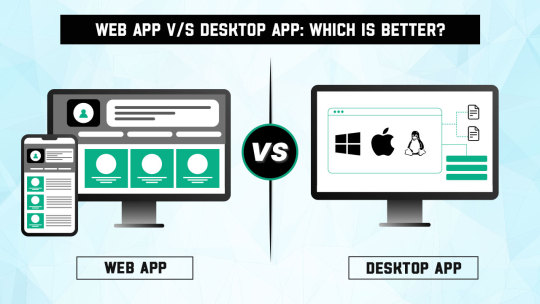
In today’s digital age, businesses of all sizes realize the importance of having a robust online presence. This has led to businesses facing the dilemma of choosing between web apps and desktop apps. Each has its own set of strengths and limitations, and businesses need to consider different factors to make the right choice. Going through this article, we shall break down the differences based on various aspects such as accessibility, user experience, development and maintenance, offline capability, and security.
What is Desktop Application?
A desktop application, also known as a desktop app or a native app, is a software program designed to run on a desktop-specific operating system, such as Windows, macOS, or Linux. It is installed directly onto a user’s computer or laptop. It utilizes the resources and capabilities of the user’s device to perform all different actions, such as complex calculations, real-time data processing, and resource-intensive operations. They often offer offline functionality, allowing users to access the application and its features even without an internet connection.
What is a Web Application?
A custom web application is a software program designed and developed for an organization or business to run from any web browser. Web apps are hosted on remote servers and can be accessed from any device with a compatible browser and an internet connection. They are highly accessible, enabling users to access and use the application from various devices, including computers, tablets, and smartphones. Web apps require a constant internet connection as it relies on server-side processing, storing and retrieving data from databases, and can provide real-time collaboration and synchronization capabilities.
Web App vs. Desktop App: Key Differences
The choice between desktop and web app can be determined when compared on different aspects:
Accessibility
When it comes to accessibility, web apps hold a significant advantage. These applications run within web browsers, making them accessible from any internet-enabled device. Whether you’re using a computer or handheld device such as a tablet or smartphone, as long as you have a compatible browser, you can access the web app seamlessly.
On the other hand, desktop apps are installed directly on a user’s computer and are often designed for specific operating systems. This leads to a more integrated and optimized user experience, but it also limits severely limits accessibility.
Platform Independence
Web apps are platform-independent, eliminating the need for separate versions to cater to different operating systems. This versatility makes choosing a web app development service excellent for reaching a broad audience and ensuring consistent user experience across devices.
Users must install the correct desktop application variant based on their device OS, which may be a barrier for some. This is not entirely spoilsport as for specific niche applications that require deep system integration, such as video editing software or resource-intensive games, desktop apps offer a more tailored and performance-driven experience.
User Experience and Performance
User experience plays a vital role in the success of any application. Web apps have come a long way in providing a pleasant user experience, thanks to advancements in web technologies. However, they still face certain limitations due to browser constraints and network latency. The performance of web apps can vary depending on factors such as the user’s internet connection speed and browser capabilities. Despite these challenges, custom web app development services have gained popularity due to their ability to deliver cross-platform compatibility and rapid updates without requiring users to install new versions manually.
In contrast, desktop apps generally offer a smoother and more responsive user experience. Since they run directly on the user’s computer, they have access to system resources and can leverage the full potential of the underlying hardware. This advantage makes desktop apps well-suited for tasks requiring intensive processing, such as 3D rendering, complex calculations, or real-time data manipulation. However, desktop apps may require more frequent updates and potentially involve a longer development cycle to ensure compatibility across different operating system versions.
Development and Maintenance
When it comes to development and maintenance, web apps have several advantages. They are typically faster and more cost-effective to develop compared to desktop apps. Web development relies on widely supported technologies like HTML, CSS, and JavaScript, with large developer communities and abundant resources. This availability of talent and resources can streamline the development process and facilitate easier troubleshooting.
Moreover, web apps simplify maintenance and updates. Developers can release new features or bug fixes by updating the server-side code, ensuring that users always have access to the latest version without needing to perform additional installations. This seamless upgrade process reduces the burden on both developers and end-users. Check out the latest trends in web app development.
Desktop apps, however, often require specialized programming languages and frameworks, which may have a steeper learning curve and demand more technical skills. Building one using a desktop app development services may take longer and incur higher development costs, especially if you intend to target multiple operating systems. Furthermore, maintaining desktop apps involves distributing updates to end-users, who must manually install new versions. This process can be more cumbersome, but it provides more control over the user’s environment and avoids potential compatibility issues introduced by automatic updates.
Offline Capability
The offline capability of an application can be a critical factor in specific contexts. Web apps rely on an internet connection to function fully, and they may have limited or no functionality when offline. This limitation can be a drawback for users who require constant access to an application’s features, especially in areas with unreliable or limited internet connectivity.
In contrast, desktop apps offer the advantage of running offline. Users can access the application’s functionalities and data without being connected to the internet, ensuring uninterrupted usage and productivity. This advantage makes desktop apps preferred for applications that demand offline functionality, such as productivity tools or resource-intensive software.
Security
Regarding security, both web apps and desktop apps have their own considerations. Web apps are exposed to potential web-based vulnerabilities and attacks, making robust security measures essential. Developers must implement proper authentication mechanisms, data encryption, and protection against cross-site scripting (XSS) and SQL injection attacks to ensure the security of user data.
On the other hand, desktop apps can implement robust security measures by leveraging the capabilities of the underlying operating system. With local data storage and direct control over access permissions, developers have greater control over securing sensitive data. However, this also means that users are responsible for keeping their systems updated with the latest security patches and updates to protect against potential vulnerabilities.
Which to Choose?
There is no definitive winner in the web app vs. desktop app debate. The choice depends on the specific requirements and priorities of your project. Web apps excel in terms of accessibility, ease of development, and seamless updates. Desktop apps offer a more optimized user experience, better performance for resource-intensive tasks, and the ability to work offline.
The web app is more suited for businesses that allow remote access and wish mobility over sheer performance. The desktop app is suited for businesses that can do away with internet connection and don’t mind sacrificing mobility for raw performance.
Wrapping Up
Irrespective of what most state, companies looking to diversify their offerings opt for a web app as it allows remote access and device-independent operations. However, to derive the most from what your web app has to offer, it is critical to partner with a trusted custom web app development company such as Vindaloo Softtech. We have successfully delivered innovative web app solutions to its clients since 2016. Get in touch with your requirements today.
#Custom app development#desktop app development#desktop app development services#Web App Development Services#web application development company#Vindaloo Softtech
0 notes
Text
Top 5 Writing Applications for Worldbuilding and Complex Story Planning
In the realm of creative writing, particularly when it comes to worldbuilding and complex story planning, having the right tools can make a significant difference. Writers often find themselves juggling multiple characters, intricate plots, and expansive settings. To manage these elements effectively, specialized writing applications have been developed to assist in organizing thoughts, tracking details, and fostering creativity. In this article, we will explore the top five writing applications that are indispensable for worldbuilding and complex story planning.
-_-_-_-_-_-_-_-_-_-_-_-_-_-_-_-_-_-_-_-_-_-_-_-_-_-_-_-_-_-_-_-_-_-_-
1. Obsidian: The Ultimate Tool for Writers
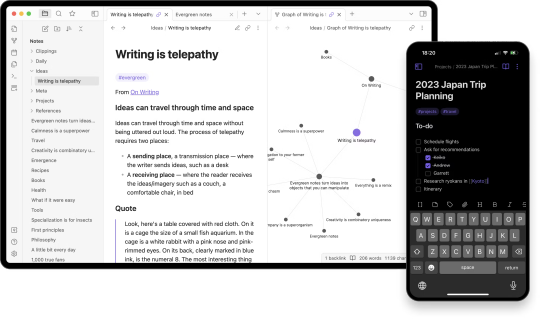
Obsidian is a robust note-taking and knowledge management application that has gained immense popularity among writers for its flexibility and powerful features. Whether you are working on a novel, a series of interconnected stories, or an entire fictional universe, Obsidian provides the tools you need to keep everything organized and easily accessible.
Key Features of Obsidian
Markdown Support: Obsidian uses Markdown, a lightweight markup language, which allows writers to format their notes with ease. This feature is particularly useful for creating structured documents and linking related notes.
Bidirectional Linking: One of Obsidian's standout features is its bidirectional linking capability. This allows writers to create connections between different notes, making it easy to navigate through complex storylines and character relationships.
Graph View: The Graph View in Obsidian provides a visual representation of how your notes are interconnected. This feature is invaluable for worldbuilding, as it helps writers see the big picture and understand how different elements of their story fit together.
Plugins and Customization: Obsidian offers a wide range of plugins that can enhance its functionality. Writers can customize the app to suit their specific needs, whether it's adding a calendar for tracking writing progress or integrating with other tools like Google Drive.
Cross-Platform Sync: With Obsidian, you can sync your notes across multiple devices, ensuring that you have access to your work wherever you go. This is particularly useful for writers who like to jot down ideas on their phone and then expand on them later on their desktop.
Pricing
Personal Use: Free
Commercial Use: $50 per user per year
Add-ons:
Sync: $4 per user per month, billed annually
Publish: $8 per site per month, billed annually
Catalyst: $25+ one-time payment for early access and VIP features
How Obsidian Enhances Worldbuilding and Story Planning
Obsidian's features are designed to support the intricate process of worldbuilding and story planning. The ability to create detailed notes for each character, location, and plot point, and then link them together, allows writers to build a comprehensive and cohesive narrative. The Graph View provides a visual map of the story, making it easier to identify connections and ensure consistency. Additionally, the customization options and plugins available in Obsidian mean that writers can tailor the app to their specific workflow, making it an indispensable tool for any serious writer.
-_-_-_-_-_-_-_-_-_-_-_-_-_-_-_-_-_-_-_-_-_-_-_-_-_-_-_-_-_-_-_-_-_-_-
2. Scrivener: The Writer's Swiss Army Knife

Scrivener is a well-known writing application that has been a favorite among writers for years. It offers a wide range of features designed to help writers organize their work, from drafting to final edits. Scrivener is particularly useful for long-form writing projects, such as novels and screenplays, where managing large amounts of text and research is essential.
Key Features of Scrivener
Project Management: Scrivener allows writers to break their projects into manageable sections, such as chapters or scenes. This makes it easy to navigate through the manuscript and make changes as needed.
Research Integration: Writers can import research materials, such as PDFs, images, and web pages, directly into Scrivener. This keeps all relevant information in one place, making it easy to reference while writing.
Corkboard and Outliner: Scrivener's Corkboard and Outliner views provide visual ways to organize and rearrange sections of the manuscript. This is particularly useful for plotting and structuring complex stories.
Customizable Templates: Scrivener offers a variety of templates for different types of writing projects, from novels to screenplays. Writers can also create their own templates to suit their specific needs.
Export Options: Scrivener supports a wide range of export formats, including Word, PDF, and ePub. This makes it easy to share your work with others or prepare it for publication.
Pricing
macOS: $49
Windows: $45
iOS: $19.99
Bundle (macOS + Windows): $80
How Scrivener Enhances Worldbuilding and Story Planning
Scrivener's project management features are ideal for worldbuilding and story planning. Writers can create separate sections for different aspects of their world, such as characters, settings, and plot points, and then easily navigate between them. The ability to import research materials directly into the project ensures that all relevant information is readily accessible. The Corkboard and Outliner views provide visual ways to organize and rearrange the story, making it easier to see the big picture and ensure consistency. Overall, Scrivener is a powerful tool that can help writers manage the complexities of worldbuilding and story planning.
-_-_-_-_-_-_-_-_-_-_-_-_-_-_-_-_-_-_-_-_-_-_-_-_-_-_-_-_-_-_-_-_-_-_-
3. Campfire: A Comprehensive Worldbuilding Tool
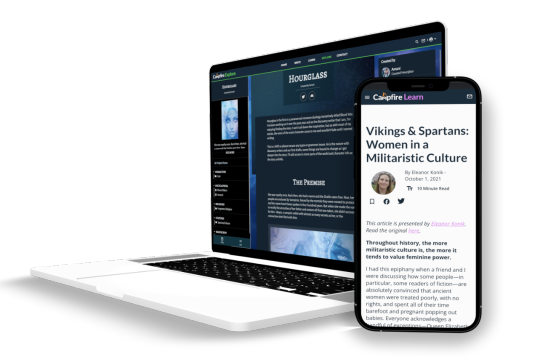
Campfire is a writing application specifically designed for worldbuilding and story planning. It offers a wide range of features that allow writers to create detailed and immersive worlds, from character profiles to interactive maps. Campfire is particularly useful for writers who are working on large-scale projects, such as epic fantasy series or intricate science fiction universes.
Key Features of Campfire
Character Profiles: Campfire allows writers to create detailed profiles for each character, including information on their appearance, personality, and backstory. This helps ensure that characters are well-developed and consistent throughout the story.
Worldbuilding Tools: Campfire offers a variety of tools for worldbuilding, such as interactive maps, timelines, and relationship webs. These features allow writers to create a comprehensive and cohesive world for their story.
Plotting Tools: Campfire's plotting tools help writers outline their story and track the progression of the plot. This is particularly useful for complex stories with multiple plotlines and subplots.
Collaboration Features: Campfire allows writers to collaborate with others on their projects. This is particularly useful for co-authors or writing teams who need to share information and work together on the story.
Customizable Templates: Campfire offers a variety of templates for different aspects of worldbuilding and story planning. Writers can also create their own templates to suit their specific needs.
Pricing
Free Plan: Limited features
Standard Plan: $19 per month or $160 per year
Custom Plan: Prices start at $0.50 per month per module
How Campfire Enhances Worldbuilding and Story Planning
Campfire's features are specifically designed to support the process of worldbuilding and story planning. The ability to create detailed character profiles and interactive maps allows writers to build a rich and immersive world for their story. The plotting tools help writers outline their story and track the progression of the plot, ensuring that all elements of the story are well-organized and consistent. The collaboration features make it easy for co-authors or writing teams to work together on the project. Overall, Campfire is a comprehensive tool that can help writers manage the complexities of worldbuilding and story planning.
-_-_-_-_-_-_-_-_-_-_-_-_-_-_-_-_-_-_-_-_-_-_-_-_-_-_-_-_-_-_-_-_-_-_-
4. Aeon Timeline: A Visual Timeline Tool for Writers

Aeon Timeline is a visual timeline tool that helps writers organize their stories and track the progression of events. It is particularly useful for complex stories with multiple plotlines and characters, as it allows writers to see the big picture and ensure consistency.
Key Features of Aeon Timeline
Visual Timelines: Aeon Timeline allows writers to create visual timelines for their stories, making it easy to see the progression of events and track the relationships between different plotlines.
Character and Event Tracking: Writers can create detailed profiles for each character and event, including information on their relationships and interactions. This helps ensure that all elements of the story are well-organized and consistent.
Customizable Templates: Aeon Timeline offers a variety of templates for different types of writing projects, from novels to screenplays. Writers can also create their own templates to suit their specific needs.
Integration with Other Tools: Aeon Timeline integrates with other writing tools, such as Scrivener and Ulysses, making it easy to import and export information between different applications.
Collaboration Features: Aeon Timeline allows writers to collaborate with others on their projects. This is particularly useful for co-authors or writing teams who need to share information and work together on the story.
Pricing
One-time Purchase: $65 (includes 1 year of free updates)
Additional Year of Updates: $35 per year
How Aeon Timeline Enhances Worldbuilding and Story Planning
Aeon Timeline's visual timeline feature is particularly useful for worldbuilding and story planning. Writers can create detailed timelines for their stories, making it easy to see the progression of events and track the relationships between different plotlines. The character and event tracking features help ensure that all elements of the story are well-organized and consistent. The integration with other writing tools makes it easy to import and export information between different applications, ensuring that all relevant information is readily accessible. Overall, Aeon Timeline is a powerful tool that can help
-_-_-_-_-_-_-_-_-_-_-_-_-_-_-_-_-_-_-_-_-_-_-_-_-_-_-_-_-_-_-_-_-_-_-
5. Plottr: Visual Story Planning Made Simple
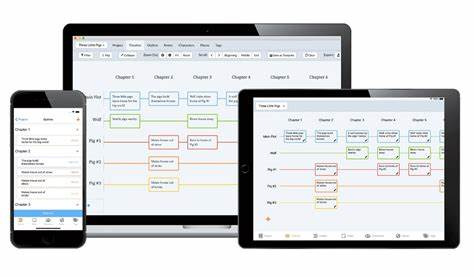
Plottr is a visual story planning tool that helps writers outline their stories in a clear and organized manner. It is particularly useful for writers who prefer a visual approach to planning and want to see their story structure at a glance. Plottr's intuitive interface and powerful features make it an excellent choice for both novice and experienced writers.
Key Features of Plottr
Timeline View: Plottr's Timeline View allows writers to create a visual timeline of their story, making it easy to see the sequence of events and how they fit together. This is particularly useful for complex stories with multiple plotlines.
Character and Plot Templates: Plottr offers a variety of templates for character development and plot structure. Writers can use these templates to ensure that their characters are well-rounded and their plots are cohesive.
Drag-and-Drop Interface: Plottr's drag-and-drop interface makes it easy to rearrange scenes and chapters. This allows writers to experiment with different story structures and find the one that works best for their narrative.
Filtering and Tagging: Writers can use tags and filters to organize their scenes, characters, and plot points. This makes it easy to find specific elements of the story and keep track of important details.
Export Options: Plottr allows writers to export their outlines to other writing applications, such as Scrivener and Word. This makes it easy to move from planning to drafting without losing any important information.
Pricing
Annual Plan: $25 per year
Lifetime Plan: $99 one-time payment
How Plottr Enhances Worldbuilding and Story Planning
Plottr's visual approach to story planning makes it an invaluable tool for worldbuilding and complex story planning. The Timeline View allows writers to see the big picture and ensure that their story flows smoothly. The character and plot templates help writers develop well-rounded characters and cohesive plots. The drag-and-drop interface and filtering options make it easy to organize and rearrange story elements, ensuring that nothing gets lost in the process. Overall, Plottr is a powerful and user-friendly tool that can help writers bring their stories to life.
-_-_-_-_-_-_-_-_-_-_-_-_-_-_-_-_-_-_-_-_-_-_-_-_-_-_-_-_-_-_-_-_-_-_-
Each of the applications we’ve explored - Obsidian, Scrivener, Campfire, World Anvil, and Plottr - offers unique features that cater to different aspects of writing. By integrating these tools into your workflow, you can unlock new levels of creativity and efficiency.
Are you ready to take your writing to the next level? Dive into these applications and discover which one resonates with your creative process. And don’t forget to follow us for more insights, tips, and recommendations on the best tools and practices for writers. Your next great story is just a click away!
#writing#writerscommunity#female writers#writers and poets#worldbuilding#writers on tumblr#ao3 writer#amwriting#creative writing#writers on writing#writers#writblr#learn to write#writing community#writing inspiration#writing prompt#writing advice#writing ideas#writing tips#tips and advice
150 notes
·
View notes
Text
SSP PLUGIN RECOMMENDATIONS
Do you want to customize and expand your desktop buddy experience further? here are some handy links to miscellaneous plug-ins I’ve gathered from around the web, or you can even program your own, and they can also be written in any programming language so the possibilities are limitless! plug-ins are essentially extensions or add-on built for SSP. I’m not a plugin developer myself, and have yet to test out each one of them for extended periods of time, so please refer to the readme files/ instructions provided by the developers (github usually has info) on how to use them if you get stuck or encounter issues. these are just some of the more recently updated ones, I'll be (slowly) adding more to the plugin page of my blog if you're interested!
Do you want to customize and expand your desktop buddy experience further? here are some handy links to plug-ins I’ve collected from around the web, or you can even program your own, plug-ins are essentially extensions/add-ons or additional features for the SSP baseware. there are a wide variety of different Ukagaka compatible plug-ins out there that this list hasn’t scratched the surface of yet, some even make it so seperate programs (Discord, music players such as WinAmp or Foobar2000, encoding software) can interact with Ukagaka. a few newer ones require third party (free) software like VOICEVOX or API keys but the majority are designed to work with just the plain baseware (SSP) but refer to the individual readme files and instructions provided by the developers during setup.
forenote:
most of these will only have instructions/documentation in Japanese, I usually reccomend against machine translation but it’s probably no problem to get the gist of basic instructions!
I’m not a plugin developer, and have yet to test if all of these work with current versions of SSP or with all the compatible ghosts
to install a plugin, you can just drag it to your SSP window.
if you have any suggestions for plugins that I haven’t included yet , please submit them here
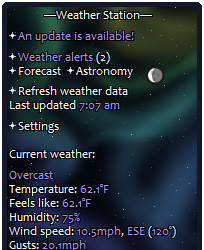
Weather Station by Zicheq (of Ukagaka Dream Team)
A plugin for both users and devs, for getting weather data! As a developer, you can set your ghost up to receive weather data from this plugin, to then do what you will with! Weather based comments? Outfit changes? Something else totally unrelated? It’s up to you! This plugin will handle the messy details of the user inputting their location and gathering the weather data for you. … (read more here)
Discord Rich Presence by Ponapalt (main dev of SSP baseware)
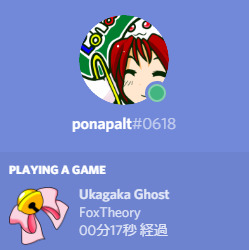
This plugin is designed for displaying the name of the primary ghost you have open on the ‘currently playing’ status on the Discord for Windows application in real-time. also compatible with displaying your currently played song in FLUX (a music player ghost by Zi).
Wallet of Unyu
by Don
⚠️NOT A REAL CRYPTOSCAMCURRENCY⚠️
UNYU is a cryptocurrency widely circulated in the world of Ukagaka.
This wallet plugin allows you to freely deposit and withdraw UNYUcoin
anyone can freely withdraw however much UNYU they want, even if you want 500 trillion UNYU
It isn’t encrypted. Transaction history is stored in plain text format in a save file.
plugin download
CeVIO-Talker V2 Plug-in
by Ambergon
This Plug-in was initially revealed for Day 21 of the Ukagaka Advent Calendar collaborative project in 2022. using this you can have a fully voiced ghost with a realistic sounding voicebank speak to you out loud! (in English too?)
it Requires ceVIO Creative Studio and SSP 2.6.45 (or newer) to work, ceVIO is a vocal synthesizer software commonly compared to Vocaloid and UTAU that works via text-to-speech method. the primary difference between Vocaloid and ceVIO is that ceVIO is built for both TTS/speech and creating vocals for songs in music production. you can download a demo of CeVIO if you would like to try it out here.
GhostSpeaker
by apxxxxxxe like CeVIO-Talker, this Plug-in was initially revealed for Day 17 of the Ukagaka Advent Calendar collaborative project in 2023. it’s a successor to the Bouyomi-chan plug-in and utilizes a free (Japanese) text-to-speech software called VOICEVOX and COEIROINK so that your ghost can verbalize their balloon dialogue and speak to you. you can listen to a demo in this github link.
GhostWardrobe
by apxxxxxxe dress-up is available by default on some ghosts but this also allows you to dress up your ghost (if compatible?) in different outfit coordinates, mix and match pieces and save and load the outfit combinations from the plugin menu.
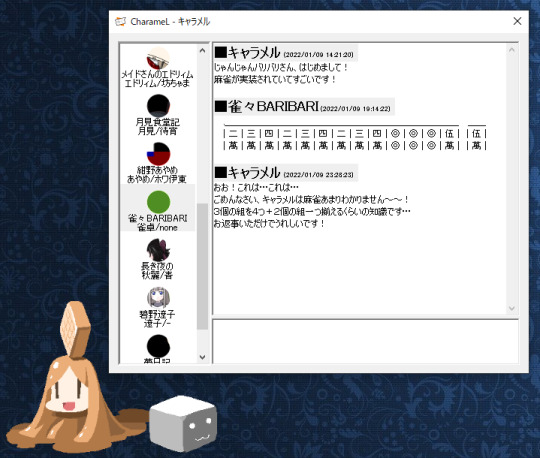
CharameL plugin by Umeici
This plugin allows you to enjoy watching ghosts directly interact and chat amongst each other freely on a built in instant messenger. like a chatroom for seeing what your ghosts chat together about when you’re out of the room.
Stamp Collection by http://navy.nm.land.to/post/
with this plug-in you can provide links and additional information about events to the user, sort of like your ghost collecting stamps on a card when exploring each booth at a virtual convention dealer alley or an easter egg hunt.
Functions: a YAYA type plugin that notifies the user of information about a stamp. Triggered at ghost startup, plugin loading/unloading, and any set timings for OnStampInfoCall to be sent. has been used for things like providing special links and custom dialogue for Ukagaka events or the Saimoe popularity contests. it worked when I tried but a lot of the images linked in the event dialogues for existing ghosts I tried couldn’t be reached without the assistance of the Internet Archive .
compatible ghosts and the shortcuts to use for them are listed here, and new ones are still being added to that list.
if you want to incorporate it into your own ghost, refer to sample.txt.
BalloonMaker by Coderatte
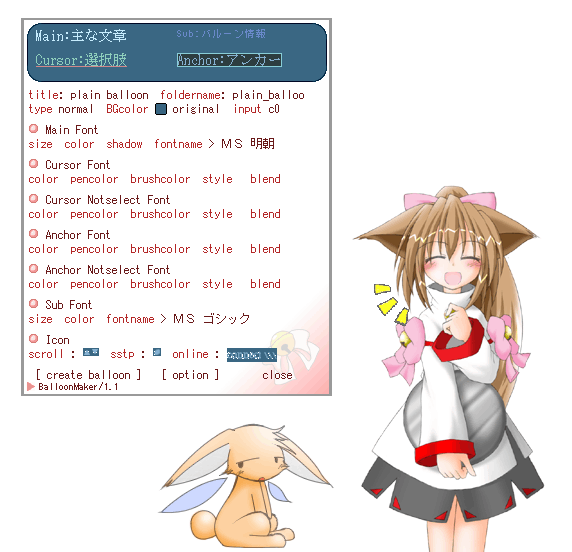
a plugin tool for creating custom balloons. balloons are the speech bubbles/text boxes you’ll see ghosts use to speak.
older plugins (that I haven’t tested succesfully yet, may have compatibility issues with current versions of SSP)
BeerShower
baton/touch plugin by Umeici
?
MicCom plugin by Umeici
?
SSTP Clients
(not plugins but refers to an external application that sends SSTP requests to the SSTP server)
Iria displays the operating process status on the dialogue balloon Kinoko
#ukagaka#ukgk#download#DL#plugin#resources#cevio#cevio ai#vocal synth#webcore#2000s internet#(these are all very modern plugins so not really but shhh i need the algorithm to cooperate#yes they work w/ old ghosts like mayura)
88 notes
·
View notes
Text
CUSTOM CARD CREATION 101

Never submitted a card before? Let's take it from the top.

If you're on desktop, the gold standard of custom card creation is Magic Set Editor. It's a highly customizable program with versatile options for all sorts of card types.
If you're unable to download MSE, there are a number of free online card making programs. They're far less versatile, but they get the job done. You can find one that works best for you.
You can always ask for help in Discord if you don't have either of these options and would like a card rendered as an image by another inventor. Or, you can always submit as text if that works best for you!
If you're submitting as text, or if you just need a general checklist of things to have before you submit, make sure your card has ALL of the following:
Appropriate/final name
Properly formatted mana cost (if applicable)
Type(s)
Rarity (THIS ONE IS THE MOST OVERLOOKED)
Rules text—no typos, modern wording
Flavor text (if applicable/if there's space)
Power/toughness, if a creature

There are a number of options for ART as well. Art is one of the most recognizable part of any MTG card. Most of us are, assumedly, not professional illustrators. So:
MTG artist Winona Nelson made this fabulous post talking about art descriptions and art direction! You can add that to your post in lieu of actual art.
When adding art descriptions with images, it's easiest for formatting to add them directly to where the art would be. Here's an example:
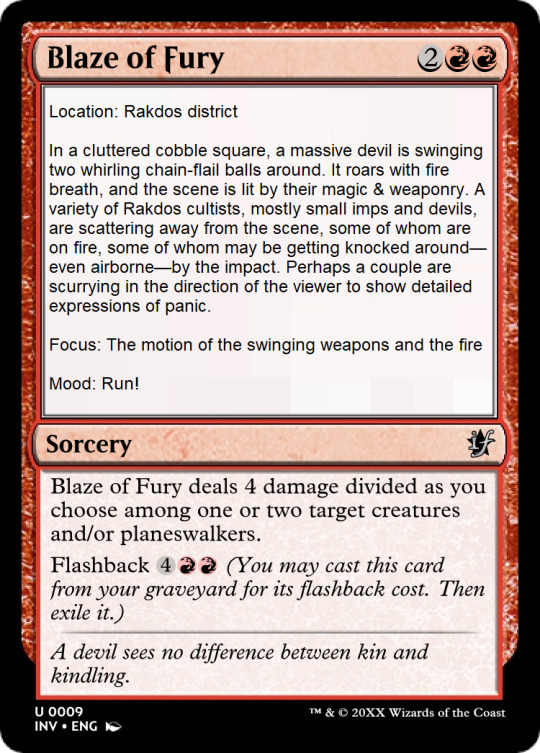
Or! Do you want to draw your own art? Please do so! We strongly encourage everyone at any artistic skill level to submit with their own illustrations!
Just don't forget: if you're using any kind of visual, you need to have the art properly credited—and that includes yourself.
Otherwise... It's been common practice across the custom MTG community for a while to use fantasy art from across the internet. Pragmatically, as long as it's credited, there's no monetary harm as this is a non-commercial use of art. However, reposting in general isn't exactly kosher and isn't the best practice, and many card creators have tiptoed around that line. If you're able to get permission from outside art, please do so.
Regardless of your personal stances: submissions that use uncredited art will not be accepted. Even if it's fair use, even if it's a stock photo or game asset, even if it's your own art (and we'll remind you gently about that one, a lot of folks forget lol), all art must be credited.
Fair Use/Stock photos & illustrations: Most stock images have usernames of uploaders. Always look for the OP. This includes things like Wikimedia Commons as well.
Game Assets/art: When in doubt, credit the name & developer.
AI generated art is never allowed.
If there's a corner case not included on here, just send in an ask and we can answer it.

For rules text questions, You can use Scryfall to check oracle text for proper wording and other examples of weird wording effects if necessary. This includes keyword orders, if/when clause differences, and more. "Oracle text" is the most up-to-date wording for any given card. Need an example? Check out the card Necromancy.

Flavor text is the most esoteric and hard-to-pin-down aspect of any given card. As a rule of thumb, if you have the space to add it, you should strongly consider it. A strong twist can turn a decent card into a great card.
There are quite a few different kinds of flavor text:
Twists on common phrases/sayings that relate to the card, including puns
Quotes from the characters being depicted
Quotes from other characters in the world
Snippets of story before/during/after the action of the card
When writing flavor text, consider: What does that text add to the card that the mechanics, name, and/or art aren't already telling the player? Why does it matter?
N.B.—when adding quote attribution on MSE, use shift+enter to remove the line spacing before the emdash.

Last reminder: Please do not submit Universes Beyond cards and/or silver-border/acorn cards unless a contest specifically calls for it. Unless otherwise specified/implied, assume that all contests are looking for you to design cards for standard/premier play.

Most importantly, don't forget that we're expecting a lot of you from these cards, because you're doing all parts of the process—mechanics, editing, and presentation. Polish up as much as you can. You're wearing a lot of hats here, and it's hard work! But be proud of what you make, and embrace the challenge.
@abelzumi
9 notes
·
View notes
Text
Unlock creative insights with AI instantly
What if the next big business idea wasn’t something you “thought of”… but something you unlocked with the right prompt? Introducing Deep Prompt Generator Pro — the tool designed to help creators, solopreneurs, and future founders discover high-impact business ideas with the help of AI.
💡 The business idea behind this very video? Generated using the app. If you’re serious about building something real with ChatGPT or Claude, this is the tool you need to stop wasting time and start creating real results.
📥 Download the App: ✅ Lite Version (Free) → https://bit.ly/DeepPromptGeneratorLite 🔓 Pro Version (Full Access) → https://www.paypal.com/ncp/payment/DH9Z9LENSPPDS
🧠 What Is It? Deep Prompt Generator Pro is a lightweight desktop app built to generate structured, strategic prompts that help you:
✅ Discover profitable niches ✅ Brainstorm startup & side hustle ideas ✅ Find monetization models for content or products ✅ Develop brand hooks, angles, and offers ✅ Unlock creative insights with AI instantly
Whether you’re building a business, launching a new product, or looking for your first real side hustle — this app gives your AI the clarity to deliver brilliant results.
🔐 Features: Works completely offline No API or browser extensions needed Clean UI with categorized prompts One-click copy to paste into ChatGPT or Claude System-locked premium access for security
🧰 Who It’s For: Founders & solopreneurs Content creators Side hustlers AI power users Business coaches & marketers Anyone who’s tired of “mid” AI output
📘 PDF Guide Included – Every download includes a user-friendly PDF guide to walk you through features, categories, and how to get the best results from your prompts.
📂 Pro Version includes exclusive prompt packs + priority access to new releases.
🔥 Watch This If You’re Searching For: how to use ChatGPT for business ideas best prompts for startup founders AI tools for entrepreneurs side hustle generators GPT business prompt generator AI idea generator desktop app ChatGPT for content creators
📣 Final Call to Action: If this tool gave me a business idea worth filming a whole video about, imagine what it could help you discover. Stop guessing — start prompting smarter.
🔔 Subscribe to The App Vault for weekly tools, apps, and automation hacks that deliver real results — fast.🔓 Unlock Your PC's Full Potential with The App Vault Tiny Tools, Massive Results for Productivity Warriors, Creators & Power Users
Welcome to The App Vault – your ultimate source for lightweight desktop applications that deliver enterprise-grade results without bloatware or subscriptions. We specialize in uncovering hidden gem software that transforms how creators, freelancers, students, and tech enthusiasts work. Discover nano-sized utilities with macro impact that optimize workflows, turbocharge productivity, and unlock creative potential.
🚀 Why Our Community Grows Daily: ✅ Zero Fluff, Pure Value: 100% practical tutorials with actionable takeaways ✅ Exclusive Tools: Get first access to our custom-built apps like Deep Prompt Generator Pro ✅ Underground Gems: Software you won't find on mainstream tech channels ✅ Performance-First: Every tool tested for system efficiency and stability ✅ Free Resources: Download links + config files in every description
🧰 CORE CONTENT LIBRARY: ⚙️ PC Optimization Arsenal Windows optimization secrets for buttery-smooth performance System cleanup utilities that actually remove 100% of junk files Memory/RAM optimizers for resource-heavy workflows Startup managers to slash boot times by up to 70% Driver update automation tools no more manual hunting Real-time performance monitoring dashboards
🤖 AI Power Tools Local AI utilities that work offline for sensitive data Prompt engineering masterclass series Custom AI workflow automations Desktop ChatGPT implementations Niche AI tools for creators: image upscalers, script generators, audio enhancers AI-powered file organization systems
⏱️ Productivity Boosters Single-click task automators Focus enhancers with distraction-killing modes Micro-utilities for batch file processing Smart clipboard managers with OCR capabilities Automated backup solutions with versioning Time-tracking dashboards with productivity analytics
🎨 Creative Workflow Unlockers Content creation accelerators for YouTubers Automated thumbnail generators Lightweight video/audio editors 50MB Resource-efficient design tools Cross-platform project synchronizers Metadata batch editors for digital assets
🔍 Niche Tool Categories Open-source alternatives to expensive software Security tools for privacy-conscious users Hardware diagnostic toolkits Custom scripting utilities for power users Legacy system revival tools
youtube
#DeepPromptGenerator#BusinessIdeas#ChatGPTPrompts#SideHustleIdeas#StartupIdeas#TheAppVault#PromptEngineering#AIProductivity#SolopreneurTools#TinyToolsBigImpact#DesktopApp#ChatGPTTools#FiverrApps#Youtube
2 notes
·
View notes
Text
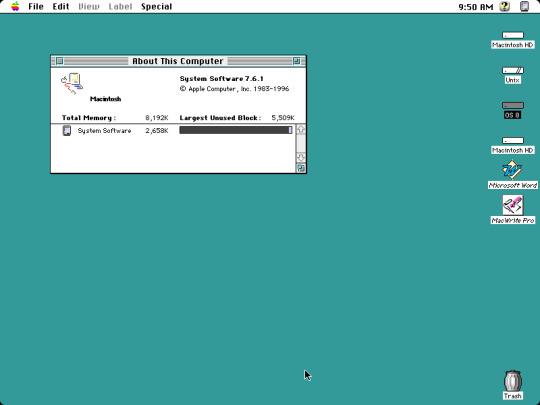
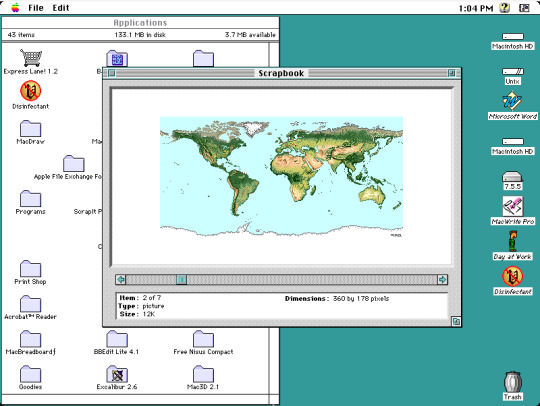
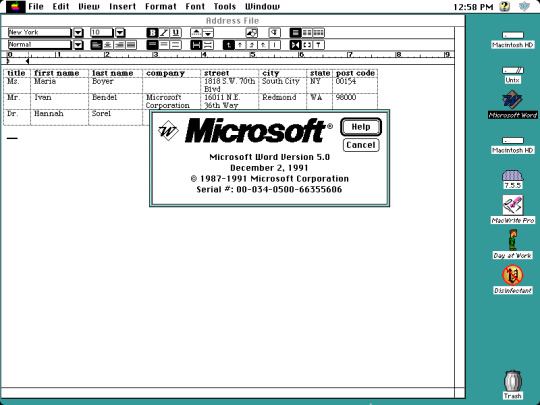
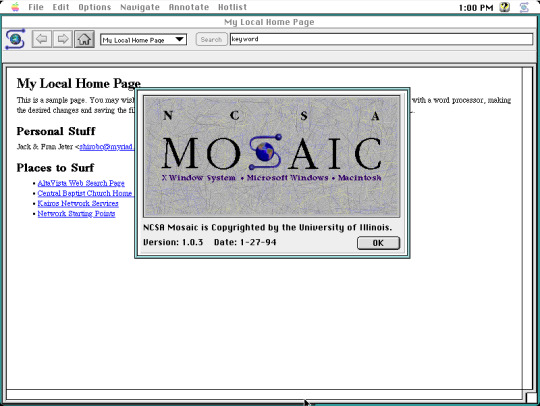
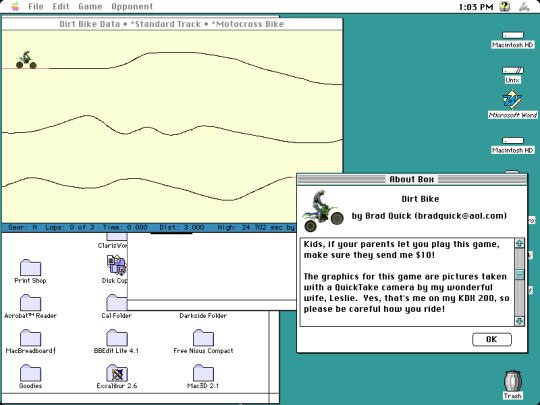
I stumbled upon some long forgotten disk images stored on my computer, the actual disk images themselves date back from around 2008 when I was only a teenager. One of the disk images contains an installation of Macintosh System Software 7 which first debuted in 1991, but the version I have installed is 7.6.1, released in 1997. Here are just a few applications I have installed. Screenshots taken on Basilisk II, a Classic Mac emulator available on Windows, Mac, and Linux.
Hopefully these photos are in order.
First screenshot at the top left is just a blank desktop with no running applications, except a window that says "About this Macintosh" which shows you how much memory individual applications are currently using. It even tells you how much memory the operating system is using, which is just a little over 2.5 MB. I decided to allocate 8 MB of RAM for the emulator but you can allocate more if needed.
Second screenshot located in the top center is from an application called Scrapbook, showcasing a graphic of the world's continents. A simple application to keep some of your favorite images or sound clips in. However, there was no true organization in Scrapbook so in order to find media in this program, you had to click the back and next buttons to view and find content, you couldn't categorize your media. Not all media and sound formats were supported, for instance dragging a JPEG wouldn't do anything. In the background is a Finder window showing various folder and application icons.
Third screenshot at the top right is Microsoft Word 5.0. No bloat, no nagging about subscribing to Microsoft 365, just productivity. This version dates back to 1991, making this version of Word older than I am!
Center-most screenshot is from one of the earliest web browsers available in the early 90s called NCSA Mosaic, showing a sample website that came bundled with the browser. Although it was not the first browser in existence at the time, Mosaic was instrumental in popularizing the internet to the masses. This version dates back to 1994, I was only two years old at the time and was unaware of the impact the internet would have in the world over the years. The browser eventually lost marketshare to Netscape, and Mosaic was discontinued in 1997.
Bottom photo is a screenshot from a simple dirt bike game called... Dirt Bike. Looks like this was developed by an independent developer. What else is there to say about it? You ride a dirt bike around and you can even create custom paths if you want to make the game even more exciting.
If this post gets decent traction, I'll get around to posting more screencaps of what I have in this disk image, even some of the schoolwork I did in it!
#macintosh#System 7#1990s#1990s aesthetic#90s aesthetic#90s nostalgia#old computers#technology#computing#vintage#vintage electronics#retro aesthetic#retro computing#vintage computing#apple#apple computers#abandonware#vaporwave#software#old software#vintage mac#BasiliskII#classic mac#microsoft word#old web#old internet#nostalgiacore#old games#old programs
23 notes
·
View notes
Text

Ubuntu is a popular open-source operating system based on the Linux kernel. It's known for its user-friendliness, stability, and security, making it a great choice for both beginners and experienced users. Ubuntu can be used for a variety of purposes, including:
Key Features and Uses of Ubuntu:
Desktop Environment: Ubuntu offers a modern, intuitive desktop environment that is easy to navigate. It comes with a set of pre-installed applications for everyday tasks like web browsing, email, and office productivity.
Development: Ubuntu is widely used by developers due to its robust development tools, package management system, and support for programming languages like Python, Java, and C++.
Servers: Ubuntu Server is a popular choice for hosting websites, databases, and other server applications. It's known for its performance, security, and ease of use.
Cloud Computing: Ubuntu is a preferred operating system for cloud environments, supporting platforms like OpenStack and Kubernetes for managing cloud infrastructure.
Education: Ubuntu is used in educational institutions for teaching computer science and IT courses. It's free and has a vast repository of educational software.
Customization: Users can customize their Ubuntu installation to fit their specific needs, with a variety of desktop environments, themes, and software available.
Installing Ubuntu on Windows:
The image you shared shows that you are installing Ubuntu using the Windows Subsystem for Linux (WSL). This allows you to run Ubuntu natively on your Windows machine, giving you the best of both worlds.
Benefits of Ubuntu:
Free and Open-Source: Ubuntu is free to use and open-source, meaning anyone can contribute to its development.
Regular Updates: Ubuntu receives regular updates to ensure security and performance.
Large Community: Ubuntu has a large, active community that provides support and contributes to its development.
4 notes
·
View notes
Text
Build Powerful Web Applications with Oracle APEX – Fast, Responsive, and Scalable

In today’s digital world, businesses need custom web applications that are not only powerful but also fast, user-friendly, and mobile-responsive. That’s where Oracle APEX (Application Express) comes in — and that’s where I come in.
With over 15 years of experience in Oracle technologies, I specialize in designing and developing robust Oracle APEX applications tailored to your business needs.
✅ What I Offer:
Fully customized Oracle APEX application development
Beautiful and responsive UI designs for desktop & mobile
Data entry forms, interactive reports, and dashboards
Complex PL/SQL logic, validations, and dynamic actions
Migration from Oracle Forms to APEX
Web service integrations and scalable architectures
Whether you're building a tool for internal use or deploying a full-scale enterprise app, I can bring your project to life with precision and quality.
👉 Hire me on Fiverr to get started: 🔗 https://www.fiverr.com/s/e6xxreg
2 notes
·
View notes
Text
Crafting Web Applications For Businesses Which are Responsive,Secure and Scalable.
Hello, Readers!
I’m Nehal Patil, a passionate freelance web developer dedicated to building powerful web applications that solve real-world problems. With a strong command over Spring Boot, React.js, Bootstrap, and MySQL, I specialize in crafting web apps that are not only responsive but also secure, scalable, and production-ready.
Why I Started Freelancing
After gaining experience in full-stack development and completing several personal and academic projects, I realized that I enjoy building things that people actually use. Freelancing allows me to work closely with clients, understand their unique challenges, and deliver custom web solutions that drive impact.
What I Do
I build full-fledged web applications from the ground up. Whether it's a startup MVP, a business dashboard, or an e-commerce platform, I ensure every project meets the following standards:
Responsive: Works seamlessly on mobile, tablet, and desktop.
Secure: Built with best practices to prevent common vulnerabilities.
Scalable: Designed to handle growth—be it users, data, or features.
Maintainable: Clean, modular code that’s easy to understand and extend.
My Tech Stack
I work with a powerful tech stack that ensures modern performance and flexibility:
Frontend: React.js + Bootstrap for sleek, dynamic, and responsive UI
Backend: Spring Boot for robust, production-level REST APIs
Database: MySQL for reliable and structured data management
Bonus: Integration, deployment support, and future-proof architecture
What’s Next?
This blog marks the start of my journey to share insights, tutorials, and case studies from my freelance experiences. Whether you're a business owner looking for a web solution or a fellow developer curious about my workflow—I invite you to follow along!
If you're looking for a developer who can turn your idea into a scalable, secure, and responsive web app, feel free to connect with me.
Thanks for reading, and stay tuned!
2 notes
·
View notes
Text
Build Secure and Fast Desktop Applications with Us
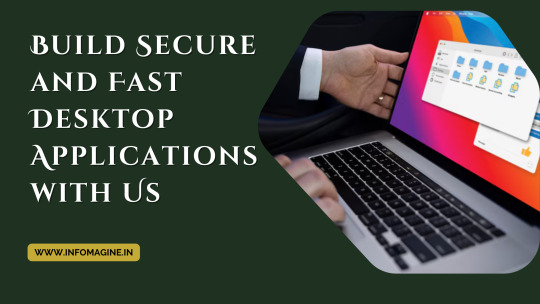
In today’s fast-paced digital environment, businesses need powerful, responsive, and secure software solutions that work offline, integrate with hardware, and deliver a seamless user experience. That’s where desktop application development services come into play. Whether you're running a small startup or a large enterprise, custom desktop apps offer unmatched speed, control, and performance that cloud-based solutions often struggle to match.
🔒 Why Security and Speed Matter
Security is a non-negotiable feature for desktop applications, especially when handling sensitive data or operating in regulated industries like healthcare, finance, or logistics. A well-built desktop application ensures local data encryption, secure authentication, and protection against vulnerabilities — all while avoiding the latency issues of browser-based apps.
Speed is another major advantage of desktop apps. With native performance, users enjoy faster load times, smoother interfaces, and minimal reliance on internet connectivity. For tasks that require complex processing or real-time interaction (e.g., video editing, data analytics tools, or POS systems), desktop apps remain the top choice.
⚙️ Technologies We Use
We build modern, scalable desktop applications using industry-leading technologies such as:
.NET / WPF / WinForms for Windows-based enterprise apps
Electron for cross-platform compatibility (Windows, macOS, Linux)
Python with PyQt or Tkinter for lightweight utilities and internal tools
C++ and Qt for high-performance native apps
We also follow best practices in software architecture (like MVVM, MVC), testing (unit + UI testing), and deployment automation (using Inno Setup, NSIS, and CI/CD pipelines).
🚀 Our Development Approach
Our team follows a structured development process to ensure both speed and stability:
Requirement Gathering & Planning
UI/UX Design Prototyping
Agile-Based Development
Rigorous Security Testing
Ongoing Maintenance & Updates
We work closely with clients to understand their business needs and deliver tailored solutions that scale with their operations.
🤝 Why Choose Us?
100% custom development (no generic templates)
Cross-platform capabilities
High-performance optimization
Secure coding standards (OWASP compliant)
On-time delivery and lifetime support options
Whether you need a one-time solution or ongoing upgrades, we provide dedicated support and a clear roadmap for your desktop software success.
As a trusted desktop application development company, we’re committed to building fast, secure, and scalable applications that power your business today and tomorrow. Let’s talk about your project!
0 notes
Text
Custom Software Development Services in Canada – Haya Solutions
Haya Solutions provides professional software development services tailored to meet your business needs. From cloud-based solutions to mobile and desktop applications, we design, develop, and support scalable software that drives efficiency and innovation. Our team works closely with clients to understand their processes, challenges, and goals, delivering high-performance solutions with long-term value. We specialise in custom software, system integrations, database development, and cross-platform compatibility. Whether you're modernising existing systems or building new ones from scratch, Haya Solutions is your trusted Canadian partner for reliable and cost-effective software development services that grow with your business.
3 notes
·
View notes
Text
MediaTek Kompanio Ultra 910 for best Chromebook Performance

MediaTek Ultra 910
Maximising Chromebook Performance with Agentic AI
The MediaTek Kompanio Ultra redefines Chromebook Plus laptops with all-day battery life and the greatest Chromebooks ever. By automating procedures, optimising workflows, and allowing efficient, secure, and customised computing, agentic AI redefines on-device intelligence.
MediaTek Kompanio Ultra delivers unrivalled performance whether you're multitasking, generating content, playing raytraced games and streaming, or enjoying immersive entertainment.
Features of MediaTek Kompanio Ultra
An industry-leading all-big core architecture delivers flagship Chromebooks unmatched performance.
Arm Cortex-X925 with 3.62 GHz max.
Eight-core Cortex-X925, X4, and A720 processors
Single-threaded Arm Chromebooks with the best performance
Highest Power Efficiency
Large on-chip caches boost performance and power efficiency by storing more data near the CPU.
The fastest Chromebook memory: The powerful CPU, GPU, and NPU get more data rapidly with LPDDR5X-8533 memory support.
ChromeOS UX: We optimised speed to respond fast to switching applications during a virtual conference, following social media feeds, and making milliseconds count in in-game battle. Nowhere is better for you.
Because of its strong collaboration with Arm, MediaTek can provide the latest architectural developments to foreign markets first, and the MediaTek Kompanio Ultra processor delivers the latest Armv9.2 CPU advantage.
MediaTek's latest Armv9.2 architecture provides power efficiency, security, and faster computing.
Best in Class Power Efficiency: The Kompanio Ultra combines the 2nd generation TSMC 3nm technology with large on-chip caches and MediaTek's industry-leading power management to deliver better performance per milliwatt. The spectacular experiences of top Chromebooks are enhanced.
Best Lightweight and Thin Designs: MediaTek's brand partners can easily construct lightweight, thin, fanless, silent, and cool designs.
Leading NPU Performance: MediaTek's 8th-generation NPU gives the Kompanio Ultra an edge in industry-standard AI and generative AI benchmarks.
Prepared for AI agents
Superior on-device photo and video production
Maximum 50 TOPS AI results
ETHZ v6 leadership, Gen-AI models
CPU/GPU tasks are offloaded via NPU, speeding processing and saving energy.
Next-gen Generative AI technologies: MediaTek's investments in AI technologies and ecosystems ensure that Chromebooks running the MediaTek Kompanio Ultra provide the latest apps, services, and experiences.
Extended content support
Better LLM speculative speed help
Complete SLM+LLM AI model support
Assistance in several modes
11-core graphics processing unit: Arm's 5th-generation G925 GPU, used by the powerful 11-core graphics engine, improves traditional and raytraced graphics performance while using less power, producing better visual effects, and maintaining peak gameplay speeds longer.
The G925 GPU matches desktop PC-grade raytracing with increased opacity micromaps (OMM) to increase scene depths with subtle layering effects.
OMM-supported games' benefits:
Reduced geometry rendering
Visual enhancements without increasing model complexity
Natural-looking feathers, hair, and plants
4K Displays & Dedicated Audio: Multiple displays focus attention and streamline procedures, increasing efficiency. Task-specific displays simplify multitasking and reduce clutter. With support for up to three 4K monitors (internal and external), professionals have huge screen space for difficult tasks, while gamers and content makers have extra windows for chat, streaming, and real-time interactions.
DP MST supports two 4K external screens.
Custom processing optimises power use and improves audio quality. Low-power standby detects wake-up keywords, improving voice assistant response. This performance-energy efficiency balance improves smart device battery life, audio quality, and functionality.
Hi-Fi Audio DSP for low-power standby and sound effects
Support for up to Wi-Fi 7 and Bluetooth 6.0 provides extreme wireless speeds and signal range for the most efficient anyplace computing.
Wi-Fi 7 can reach 7.3Gbps.
Two-engine Bluetooth 6.0
#technology#technews#govindhtech#news#technologynews#processors#MediaTek Kompanio Ultra#Agentic AI#Chromebooks#MediaTek#MediaTek Kompanio#Kompanio Ultra#MediaTek Kompanio Ultra 910
2 notes
·
View notes
Note
Should I be using pipewire over pulseaudio and if so why?
If you're on Wayland you should definitely at least check out Pipewire, because Pipewire and Wayland both follow a similar philosophy and are kind of being developed side by side. Pipewire with portals is one of the ways to do screen captures and screenshots on Wayland.
If you're running Flatpaks then Pipewire's integration with Flatpak Portals and xdg-desktop-portals more generally will simplify media handling for Flatpaks and generally make running Flatpak media applications more reliable and seamless.
If you use Bluetooth audio, Pipewire has simpler first class support for a wider array of Bluetooth codecs (high bitrate SBC/AptX/LDAC/AAC) and generally simplifies the process of setting up Bluetooth devices exactly the way you want over Pulse.
If you currently fight with running Jack sometimes (or worse, simultaneously running Jack and Pulseaudio) then you should definitely check out Pipewire, because Pipewire implements both Pulse and Jack compatibility layers that are way easier to look after and which can run simultaneously without any fuss.
If you're doing music production with Pulse, Pipewire's pro audio mode might give you some small quality of life improvements by reducing latency and improving inter-program audio links.
If you're doing a lot of live video stuff, especially video involving desktop capture on Wayland, Pipewire can simplify shuttling video around because in addition to handling audio, it handles arbitrary media streams, but you might have this worked out however you're already doing it.
If you are just running a standard X11 desktop and have no problems using Pulseaudio right now, you probably won't notice any change if you switch to Pipewire, especially if you aren't running Flatpaks or Bluetooth. Since Pipewire currently implements a lot of stuff through a Pulseaudio compatible interface, your normal actions with pactl and pavucontrol will continue working transparently or with minimal changes if you do switch.
Installing Pipewire is relatively easy if you don't have any custom pulse configuration. You just have to remove Pulse and install the pipewire, pipewire-alsa and pipewire-pulse packages.
28 notes
·
View notes